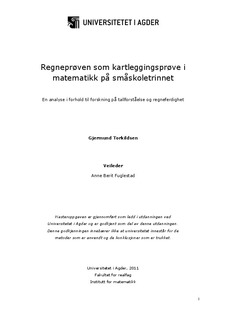| dc.contributor.author | Torkildsen, Gjermund | |
| dc.date.accessioned | 2011-09-23T11:06:50Z | |
| dc.date.available | 2011-09-23T11:06:50Z | |
| dc.date.issued | 2011 | |
| dc.identifier.uri | http://hdl.handle.net/11250/138104 | |
| dc.description | Masteroppgave i matematikkdidaktikk- Universitetet i Agder 2011 | en_US |
| dc.description.abstract | This master thesis is about an obligatory national assessment test in numeracy and calculation for 2nd grade in Norwegian primary school, referred to as “Regneprøven”. The following research questions have been formulated based on a development project at three schools:
What information could Regneprøven provide on students' numeracy and arithmetic skills after 2nd grade?
In order to refine the research question and the research field, I have asked the four questions below:
I. What is the theoretical basis for Regneprøven?
II. In what way do Regneprøven and the competency goals of LK06 correspond?
III. In what way do Regneprøven and the theoretical basis of this test correspond?
IV. What can Regneprøven provide of information on number comprehension and arithmetic skills can of the students in my data that come under the critical limit?
I understand the term theoretical basis as the research literature the development of Regneprøven has been based on. The theoretical basis refers specifically to a range of international research-based frameworks that describes children's development of numeracy and calculation skills.
Results In this master thesis I find that there is great consistency between the framework for Regneprøven and the theoretical basis. I also examine Regneprøven mapping the competency goals of the curriculum. My analysis shows that Regneprøven mainly maps the student's counting skills. Parts of the competency goals are to a smaller extent mapped, and some are not mapped at all. For a couple of competency goals it is not clear whether they are mapped on Regneprøven or not, and I discuss the reasons for this.
In the development project on the three schools the teachers discussed the results of the pupil. I use data from the implementation of Regneprøven in 2009 and 2010 and conclude that the distance between the pupils during the critical limit compared with the total group of pupils increases from 2nd to 3rd grade. Some tasks in Regneprøven turns out to be particularly demanding for the pupils. These tasks can still provide information about pupils under the critical limit.
Pedagogical implications It should be considered whether Regneprøven should be supplied with qualitative assessment.
The results of Regneprøven must be followed up by the teacher in relation to identifying which pupils have a worrying development. It can also be fruitful to a team of teachers to discuss what information such assessment can provide. | en_US |
| dc.language.iso | nob | en_US |
| dc.publisher | Universitetet i Agder; University of Agder | en_US |
| dc.subject.classification | MA 500 | |
| dc.title | Regneprøven som kartleggingsprøve i matematikk på småskoletrinnet : en analyse i forhold til forskning på tallforståelse og regneferdighet | en_US |
| dc.type | Master thesis | en_US |
| dc.subject.nsi | VDP::Mathematics and natural science: 400::Mathematics: 410::Applied mathematics: 413 | en_US |
| dc.source.pagenumber | 152 s. | en_US |
